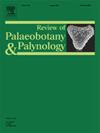白蜡树在塞浦路斯灭绝了吗?
IF 1.7
3区 地球科学
Q2 PALEONTOLOGY
引用次数: 0
摘要
白蜡属(Fraxinus L.)是油橄榄科(OLEACEAE)植物的一个属,广泛分布于欧洲、亚洲和北美。目前在塞浦路斯发现的三种白蜡树(f.a guustifolia Vahl, f.a excelsior L., f.o ornus L.)是可以追溯到公元19世纪和20世纪的现代引进物种。然而,从塞浦路斯考古遗址中发现的木炭(人类学)碎片表明,在全新世早期,当地植物区系中存在着黄曲霉属。本文回顾了塞浦路斯灰烬(Fraxinus spp.)存在的现有数据,并在Parekklishia-Shillourokambos(公元前8600-6900 cal)的早期陶瓷新石器时代遗址和Khirokitia (Choirokoitia)-Vounoi(公元前6800-5500 cal)的晚期陶瓷新石器时代遗址展示了其开采的证据。这些数据表明,在全新世早期,塞浦路斯就存在着Fraxinus,因此有助于我们了解其过去的生物地理,以及塞浦路斯的植被历史和古生态,以及遗址周围的环境。本文章由计算机程序翻译,如有差异,请以英文原文为准。
Did ash (Fraxinus) become extinct on Cyprus?
Fraxinus L., ash, is a genus of plants in the olive family (OLEACEAE) with a large distribution in Europe, Asia, and North America. The three ash species attested today in Cyprus (F. angustifolia Vahl, F. excelsior L., F. ornus L.) are modern introductions dated to the 19th and 20th centuries CE. However, remains of wood charcoal (anthracological) fragments recovered from archaeological sites in Cyprus suggest the presence of Fraxinus in the local flora during the Early Holocene. This article reviews the available data on the presence of ash (Fraxinus spp.) in Cyprus and shows evidence for its exploitation at the Early Aceramic Neolithic site of Parekklishia-Shillourokambos (8600–6900 cal BCE) and the Late Aceramic Neolithic site of Khirokitia (Choirokoitia)-Vounoi (6800–5500 cal BCE). This data demonstrates that Fraxinus was present in Cyprus during the Early Holocene and therefore contributes to our understanding of its past biogeography as well as to the vegetation history and palaeoecology of Cyprus, and the environment around the sites.
求助全文
通过发布文献求助,成功后即可免费获取论文全文。
去求助
来源期刊
CiteScore
3.50
自引率
21.10%
发文量
149
审稿时长
6 months
期刊介绍:
The Review of Palaeobotany and Palynology is an international journal for articles in all fields of palaeobotany and palynology dealing with all groups, ranging from marine palynomorphs to higher land plants. Original contributions and comprehensive review papers should appeal to an international audience. Typical topics include but are not restricted to systematics, evolution, palaeobiology, palaeoecology, biostratigraphy, biochronology, palaeoclimatology, paleogeography, taphonomy, palaeoenvironmental reconstructions, vegetation history, and practical applications of palaeobotany and palynology, e.g. in coal and petroleum geology and archaeology. The journal especially encourages the publication of articles in which palaeobotany and palynology are applied for solving fundamental geological and biological problems as well as innovative and interdisciplinary approaches.

 求助内容:
求助内容: 应助结果提醒方式:
应助结果提醒方式:


